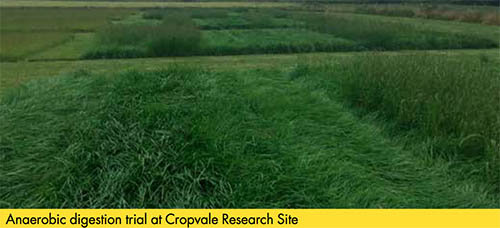BAR FORAGE MIXTURES
Now into its second harvest year, our mixture demonstration has had two cuts so far in 2017: one in mid May and a second at the end of June. In terms of overall yield, the Italian ryegrass-based High D and red clover / hybrid ryegrasss blend has been the highest yielding overall. Interestingly however, multi-species mixture Barmix is ranking third this year. This is due to the drought tolerance of both the cocksfoot and tall fescue species within the mixture, which is yielding only 500kg DM/ha behind the second year Italians! The ryegrass-free, equine grazing mixture we have sown is also faring well because of the presence of similar species.
BRASSICAS & FORAGE CROPS
The short-term brassicas planted at Cropvale have established well and are looking fantastic, especially the stubble turnips. Our kale plants have suffered a little damage and are thinner than we’d expect but are starting to improve. To push them along they will be given a small application of fertiliser. Our vetch was unfortunately ‘grazed out’ by some local pigeons so we re-sowed it and put it under fleece with a lot more success second time round!
The clover and lucerne plots are looking well with the Ensign white clover blend showing a good variety of leaf sizes from the different varieties in the mix. Probably the most impressive area is the Bar Finisher plot, which contains chicory and plantain plus red and white clover. These plots have established well with a high plant population and have been of great interest to several groups of visitors who have made the trip to Cropvale this year. The plots were a particular focus for James and Latham when they hosted a visit by twelve NSA New generation sheep farmers in mid July.
ANAEROBIC DIGESTION TRIAL

Our bio-digester trial will reach its conclusion at the end of this year and our two main cuts of 2017 have already been taken. Combining the information from these two harvests with data from the previous two years, we’ve been able to draw some preliminary conclusions.
For growers looking for a very short-term option for anaerobic digestion input, we believe Italian ryegrass remains the best choice. However for producers looking for longer term grass – particularly in more drought prone areas – a blend of tetraploid Italian ryegrass and soft leaved tall fescue is coming out on top over the course of the three years. In this mix, the Italian ryegrass boosts the yield in the first year as the tall fescue establishes. Then, the tall fescue provides its best yields in subsequent years. As well as yielding well, the varieties included in this trial have shown incredibly good disease resistance. At the end of year we’ll draw our final conclusions and report back.
WILD FLOWERS

It is estimated that around 95% of British wildflower meadows were lost after the Second World War – but thankfully, we are now seeing increased interest in native wildflowers – thanks in part to higher-level environmental stewardship schemes. Establishing flower rich margins on the edges of fields can be hugely beneficial – helping farmers maintain a healthy ecosystem and attracting insects, which in turn can help to fertilise crops.
With around 1500 different wild flowers available in the UK, it can be hard for farmers to know which wild flowers to grow. To make it easier, Barenbrug has added 21 wild flower mixtures to the range of seeds it offers.
To demonstrate the value of wild flowers, we’ve been trialling some of the mixtures at Cropvale, adding colour and interest to the site as well as improving its biodiversity. If you are interested in adding wild flowers to your margins, August and September are the ideal months to sow seeds. Our range of wild flowers include both annual and perennial mixtures and can be pure wild flower or mixed with grass to satisfy a range of situations and requirements.
2018
As we head towards autumn we are putting plans in place for several new trials. In 2018, the plan is to have a biodiversity trial and a red clover trial.
We also want to establish several demonstration plots dedicated to different species. We’ll report further on this in the next BarForage newsletter.




